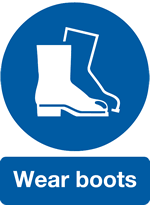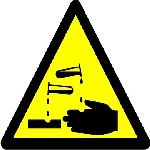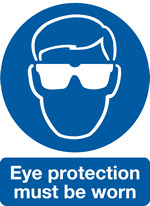Personal Protective Equipment
 In many work situations risks cannot be fully controlled at source, thus giving rise to the need for personal protective equipment (PPE), that is head protection e.g. safety helmets; eye protection e.g. spectacles, goggles or face shields; foot protection e.g. integral toe protection, special foundry boots or insulated safety boots; hand and arm protection e.g. gloves and gauntlets and protection for the body e.g. high-visibility jackets, chain mail aprons or bullet proof vests. In some situations it is necessary to wear a combination of PPE which could include helmet, full face visor, fireproof clothing, special boots etc.
In many work situations risks cannot be fully controlled at source, thus giving rise to the need for personal protective equipment (PPE), that is head protection e.g. safety helmets; eye protection e.g. spectacles, goggles or face shields; foot protection e.g. integral toe protection, special foundry boots or insulated safety boots; hand and arm protection e.g. gloves and gauntlets and protection for the body e.g. high-visibility jackets, chain mail aprons or bullet proof vests. In some situations it is necessary to wear a combination of PPE which could include helmet, full face visor, fireproof clothing, special boots etc.
The Personal Protective Equipment at Work Regulations 1992 require employers to assess tasks where risk cannot be eliminated, to assess the personal protective equipment characteristics and make comparison with others that may provide the same type of protection, to provide suitable protective equipment and to provide the user with information, instruction and training. It is also necessary to ensure when a combination of PPE is worn that they are compatible one with another. There is also a duty on the employee to use such personal protective equipment as is provided.
 We have wide experience of investigations involving the use of or failure to use personal protective equipment, providing opinions on whether an employer has complied with their duties under the Regulations and indeed the common law requirements in this respect.
We have wide experience of investigations involving the use of or failure to use personal protective equipment, providing opinions on whether an employer has complied with their duties under the Regulations and indeed the common law requirements in this respect.


